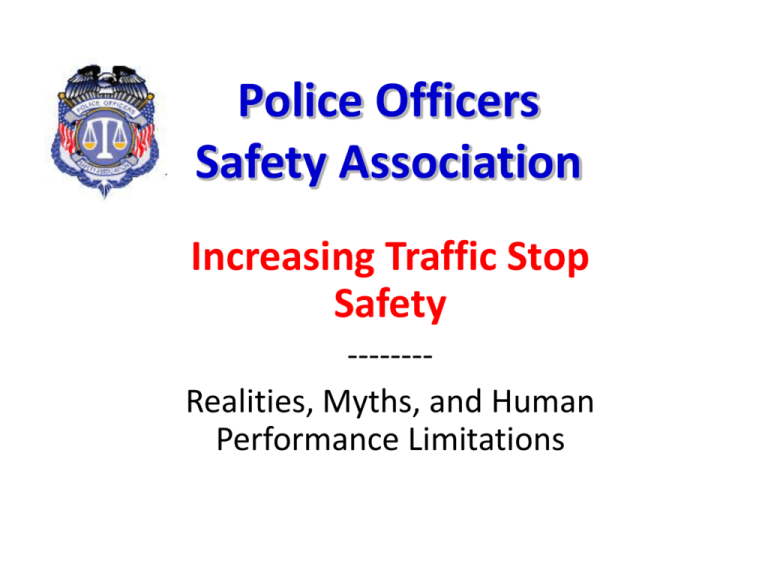Firefighters Support Foundation - Police Officers Safety Association
advertisement

Police Officers Safety Association Increasing Traffic Stop Safety -------Realities, Myths, and Human Performance Limitations Permission Permission is granted to reproduce or distribute this material so long as the Police Officer Safety Association is credited as the source 2 Accompanying Video This PowerPoint presentation accompanies the video presentation of the same title. 3 Presenter Craig Allen is 23 year veteran of law enforcement and serves as a patrol Lieutenant with the Hillsboro, Oregon, Police Department. Craig holds numerous instructor certifications ranging from firearms, defensive tactics, and less lethal weapons as well as other related tactical fields. Craig has served as a patrol officer, field-training officer, detective, narcotics detective, patrol sergeant, and SWAT assistant team leader. In 2014, Craig was selected by the Force Science Institute and graduated the extensive three month Advanced Force Specialist Course. Craig is responsible for research and development of the agency’s high liability areas relating to force response and is a court recognized expert on police force response. Craig has taught extensively both locally at the state/regional level on these matters. 4 Presenter Roberto DiGiulio is 12 year veteran of law enforcement and serves as a Training Officer with the Hillsboro, Oregon, Police Department. Roberto holds numerous instructor certifications ranging from firearms, defensive tactics, and less lethal weapons as well as other related tactical fields. Roberto has served as a member of an inner agency SWAT team and in training. Roberto has taught both locally at the state/regional level on matters concerning force and tactics. Roberto is a certified Force Analyst through the Force Science Institute and has taught extensively on the human factors associated with making decisions under stress. Roberto currently teaches Tactical Communication and Crisis Intervention at Portland Community College. 5 The Traffic Stop • • • • One of the most routine activities LEOKA Implications of Science behind the stop Recommendations – Limitations of human performance – Increase perception – Tactical considerations 6 The Traffic Stop • Unknown and known risk • Self initiated and Engineered by the officer • Commonalities within the profession 7 Difference • • • • Driver approach Flip at the B pillar Passenger approach Call back 8 Driver Approach • Most intuitive • Typically how we do it? • A belief that approach tactics can increase survivability • B pillar / Frontal view 9 Passenger Approach • Added time to see and perceive threat • Traffic considerations • Increase escape routes https://www.youtube.com/watch?v=H0mAXmazHRg 10 Traffic Stop Study • • • • The design Realities of times Implications to officer safety Harsh realities 11 Times • Driver S = .13 -.17 O (RT) = .37 • Passenger S = .13 - .17 O (RT) = .36 • Retreat to mitigation zone D = 2.35 P = 1.5 http://www.forcescience.org/trafficstop.html 12 Example 13 The role of the Amygdala • Can you create automatic motor response? • Can you build off of the AMR • Should we engineer a safer approach 14 Can we develop safer habits • • • • Walk up / Driver & Passenger Early recognition of hands Contingency fluidity Intentional focus issue – External narrowly focused 15 Managing Time • Orientation is the key • What should I be paying attention to • Attention is singular 16 Call Back Traffic Stop • • • • • Purpose Modifications Tactical Realties Reading body mannerisms Legal aspects 17 Conclusion • Building safer habits • Inherently by design the driver has the advantage • How can we be creative to minimize that advantage. 18 Contact • Roberto DiGiulio – roberto.digiulio@hillsboro-oregon.gov • Craig Allen – craig.allen@hillsboro-oregon.gov 19 Comments POSA is always striving to improve our programs. Please send comments/suggestions to: dkenik@posai.org Thank you! Presentation title 20 Free Training Programs For more free training programs, visit www.posai.org Presentation title 21









